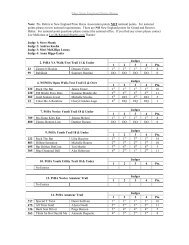2011 Official Rule Book - New England Pinto Horse Association
2011 Official Rule Book - New England Pinto Horse Association
2011 Official Rule Book - New England Pinto Horse Association
Create successful ePaper yourself
Turn your PDF publications into a flip-book with our unique Google optimized e-Paper software.
5. Exhibitors should convey the impression of effective and<br />
easy control. To show a <strong>Pinto</strong> well, he/she should show to<br />
his/her best advantage.<br />
6. Bareback Hunter Seat Equitation and Bareback Saddle<br />
Seat Equitation may be combined at discretion of Show<br />
Management.<br />
B. Hands/Reins<br />
1. Hands should be held in an easy position, neither<br />
perpendicular nor horizontal to where the saddle would be,<br />
and should show sympathy, adaptability and control.<br />
2. The height the hands are held above the <strong>Pinto</strong>’s withers is<br />
a matter of how and where the <strong>Pinto</strong> carries its head.<br />
3. The method of holding the reins is optional, except that<br />
both hands shall be used and all reins must be picked up<br />
at one time. Bight of rein should be on the off side.<br />
C. Basic Position<br />
1. To obtain proper position, exhibitors should place<br />
themselves comfortably and find their center of gravity by<br />
sitting with a slight bend at the knees.<br />
2. Foot position should be natural, neither extremely in nor<br />
out.<br />
D. Position in Motion<br />
1. At the walk, there should be slight motion.<br />
2. At the trot, slight elevation posting; not mechanical up and<br />
down nor swinging forward and backward. Hips should be<br />
under body.<br />
3. At the canter, close seat and going with the <strong>Pinto</strong>.<br />
E. Class Routine – Refer to Saddle Seat Equitation Classes.<br />
F. Additional Work – Refer to Saddle Seat Equitation Classes.<br />
T9. Reinsmanship (Driving Equitation)<br />
A. General Regulations and Requirements<br />
1. A Driving class in which the entries are judged on the ability<br />
and skill of the driver.<br />
2. The <strong>Pinto</strong> is to be shown in a harness suitable to the vehicle<br />
used.<br />
3. The vehicle should be an appropriate two (2) or four (4)<br />
wheeled vehicle with wire or wooden wheels and in sound<br />
condition. Refer to <strong>Rule</strong> P1.<br />
4. Drivers shall be required to rein back.<br />
5. All drivers chosen for a work out may be worked at any<br />
gait requested by the judge.<br />
6. A simple figure eight, or any additional work, must be<br />
posted as a pattern thirty (30) minutes prior to class.<br />
7. Attendants/Header are optional, with the exception in<br />
Youth Reinsmanship, where an attendant/header is<br />
required.<br />
B. Attire and Appointments<br />
1. Appointments of driver and attendant (header); the driver<br />
and attendants (if any) should be dressed conservatively<br />
according to the style of the present day.<br />
2. Suggested attire for gentlemen, dress pants and shirt, coat<br />
or jacket and boots.<br />
3. Suggested attire for ladies; dress, tailored suit, skirt or<br />
slacks, and blouse, vest or jacket, and boots.<br />
4. The following attire is required of all drivers; hat or<br />
protective headgear, gloves and whip in hand.<br />
5. Lap apron or robes are optional.<br />
6. Attendants should wear long pants, shirt and boots.<br />
C. Gaits to be shown at<br />
1. Walk<br />
2. Slow trot (collected)<br />
3. Working trot (normal)<br />
4. Strong trot (extended)<br />
<strong>2011</strong> PtHA <strong>Rule</strong> <strong>Book</strong> 201<br />
ClassEs



